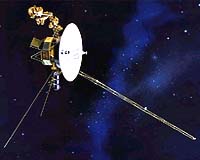 |
Pasadena CA (JPL) Apr 28, 2011 Here are five facts about NASA's twin Voyager 1 and 2 spacecraft, the longest continuously-operating spacecraft in deep space. The Voyagers were built by NASA's Jet Propulsion Laboratory in Pasadena, Calif., which continues to operate both spacecraft. 1. Long-Distance Space Runners Voyager 2 launched on Aug. 20, 1977, and Voyager 1 launched about two weeks later, on Sept. 5. Since then, the spacecraft have been traveling along different flight paths and at different speeds. Now some 17.4 billion kilometers (10.8 billion miles) from the sun and hurtling toward interstellar space, Voyager 1 is the farthest human-made object from Earth. Voyager 2 is about 14.2 billion kilometers (8.8 billion miles) from the sun. 2. Can You Hear Me Now? Both spacecraft are still sending scientific information about their surroundings through NASA's Deep Space Network. A signal from the ground, traveling at the speed of light, takes about 13 hours one way to reach Voyager 2, and 16 hours one way to reach Voyager 1. 3. Planetary Tour The primary five-year mission of the Voyagers included the close-up exploration of Jupiter and Saturn, Saturn's rings and the larger moons of the two planets. The mission was extended after a succession of discoveries, and between them, the two spacecraft have explored all the giant outer planets of our solar system - Jupiter, Saturn, Uranus and Neptune, 49 moons, and the systems of rings and magnetic fields those planets possess. The current mission, the Voyager Interstellar Mission, was planned to explore the outermost edge of our solar system and eventually leave our sun's sphere of influence and enter interstellar space - the space between the stars. 4. The Golden Record Both Voyager spacecraft carry recorded messages from Earth on golden phonograph records - 12-inch, gold-plated copper disks. A committee chaired by the late astronomer Carl Sagan selected the contents of the records for NASA. The records are cultural time capsules that the Voyagers carry with them to other star systems. They contain images and natural sounds, spoken greetings in 55 languages and musical selections from different cultures and eras. 5. Where No Spacecraft Has Gone Before Voyager 1 has reached a distant point at the edge of our solar system, where the outward motion of solar wind ceases. The event is the latest milestone in Voyager 1's passage through the heliosheath, the outer shell of the sun's sphere of influence, before entering interstellar space. Interstellar space begins at the heliopause, and scientists estimate Voyager 1 will cross this frontier around 2015.
Share This Article With Planet Earth
Related Links Voyager mission Space Tourism, Space Transport and Space Exploration News
 Aerojet Propulsion Assists Voyager 1 Precision Maneuver At The Edge Of The Solar System
Aerojet Propulsion Assists Voyager 1 Precision Maneuver At The Edge Of The Solar SystemSacramento, CA (SPX) Apr 04, 2011 Aerojet says its thrusters on the Voyager 1 spacecraft assisted in several critical repositionings of the spacecraft over 10 billion miles away from the sun, at the edge of the solar system. On March 8, 2011, the 34-year-old Voyager 1 spacecraft did the deep space equivalent of a gymnastics routine at the Olympics as it rolled 70 degrees counterclockwise from its normal orientation and hel ... read more |
|
| The content herein, unless otherwise known to be public domain, are Copyright 1995-2010 - SpaceDaily. AFP and UPI Wire Stories are copyright Agence France-Presse and United Press International. ESA Portal Reports are copyright European Space Agency. All NASA sourced material is public domain. Additional copyrights may apply in whole or part to other bona fide parties. Advertising does not imply endorsement,agreement or approval of any opinions, statements or information provided by SpaceDaily on any Web page published or hosted by SpaceDaily. Privacy Statement |